Columbus Forecast 2016
Assistant Professor of Finance, Indiana University Division of Business, IUPUC
Columbus is on track to experience its sixth consecutive year of GDP growth through 2015. Certain indications suggest, however, that momentum has reached a point of inelasticity, reducing upside opportunity for further economic expansion in 2016.
Among the metrics on track to show continued improvement include nominal and real GDP, employment, labor force and building permit applications.1 However, per capita personal income (PCPI) in 2013 (the most recent data available at the time of this writing) was down 0.2 percent from 2012 in the Columbus metropolitan statistical area.2 Additionally, the Columbus Area Stock Index (CASI) has experienced volatility recently, Cummins forecasts are down, the automotive sector may be nearing the end of its expansion, and tightened labor markets suggest further growth into 2016 will be challenging.
Measures of Concurrent Economic Vitality
Unemployment: With a current unemployment rate of just under 3 percent, Columbus has one of the most industrious labor forces anywhere in Indiana and across the United States, placing upward wage pressure on employers who seek to expand business in Columbus. Area leaders are now struggling with a deficit of available applicants as we enter the holiday retail season, when employment opportunities for service jobs tend to peak. Even so, PCPI has been flat over the latest 12 months of information available (see Figure 1). This apparent inconsistency is discussed below.
Figure 1: Per Capita Personal Income and the Unemployment Rate in the Columbus MSA
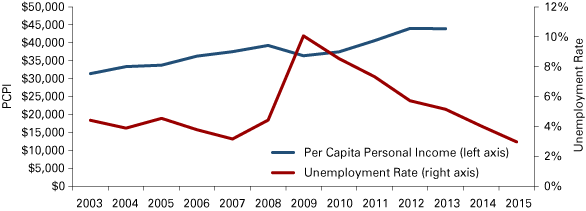
Source: U.S. Bureau of Economic Analysis and U.S. Bureau of Labor Statistics
While unemployment rates across America and Indiana have trended downward over the past year, the rate for Columbus continues to reflect the least slack anywhere in the region. See Table 1 for a comparison of unemployment rates among selected Indiana metros and micros.
Table 1: Unemployment Rate Comparison for Selected Metros and Micros
| 2011 | 2012 | 2013 | 2014 | 2015 | |
|---|---|---|---|---|---|
| U.S. | 8.8% | 7.6% | 7.0% | 5.7% | 4.9% |
| Indiana | 9.0% | 7.7% | 6.8% | 5.5% | 4.0% |
| Indianapolis-Carmel-Anderson | 8.7% | 7.4% | 6.5% | 5.2% | 3.8% |
| Bloomington | 8.1% | 7.1% | 6.3% | 5.4% | 4.3% |
| Columbus | 7.3% | 5.7% | 5.1% | 4.0% | 3.0% |
| Evansville | 7.6% | 6.9% | 6.3% | 4.9% | 3.5% |
| Kokomo | 10.1% | 8.6% | 7.2% | 5.7% | 4.1% |
| Greensburg | 9.4% | 7.3% | 5.7% | 4.5% | 3.3% |
| North Vernon | 11.3% | 9.3% | 7.9% | 5.9% | 4.0% |
| Seymour | 8.7% | 6.9% | 5.7% | 4.6% | 3.5% |
Note: Data are for September of each year and are not seasonally adjusted.
Source: U.S. Bureau of Labor Statistics and Indiana Department of Workforce Development
Employment and Labor Force: One telling aspect of the net positive direction Columbus has been experiencing over the past five years is seen through the lens of jobs available to residents of the Columbus MSA. Census data show that Columbus-area employers provided 53,000 jobs to a local labor force of only 43,968 (see Figure 2).3 This implies that Columbus employers provide a net 9,032 jobs to citizens outside of the Columbus MSA, placing upward demands on discretionary services during workdays—or leaving considerable economic impact on the table, depending on one’s perspective of the imbalance—and upward pressures on new housing options for workers who seek to eliminate their commute by relocating into the Columbus MSA. Job growth over the prior 12 months was 2,100, or 4.1 percent, while labor force growth over the prior 12 months was 1,172, or about 2.8 percent.
Figure 2: Local Jobs and Local Labor Force
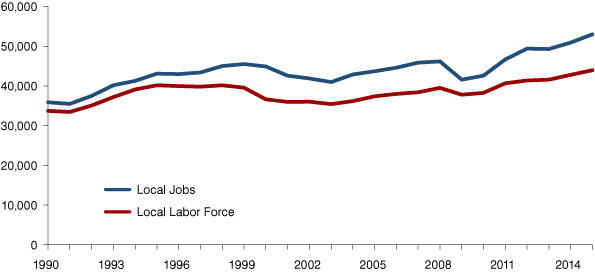
Source: U.S. Bureau of Labor Statistics and Indiana Department of Workforce Development
Job growth, wage growth, a skilled workforce, and high-tech GDP growth have earned Columbus national recognition as the second-best small city overall in America in 2014 for attracting additional capital investment.4 Examples of that kind of investment attractiveness continue into 2015, although at a slower pace than in the years following the recession.
Between 2008 and 2014, various enterprises invested or planned investment of $145 million into the Columbus economy.5 In 2015, about $100 million in planned investments have been reported by The Republic newspaper of Columbus:
- Tony Moravec and Moravec Realty LLC: $3.285 million to convert Pump House in downtown on Lindsay Street into an Upland Brewing Company brew house.6
- Impact Forge LLC: $7.5 million capital investment in new equipment and plans to hire 30 associates ($18.19 per hour, average wage) by the end of 2015.7
- Faurecia Emission Control Technologies (FECT): Plans to invest $70 million to equip and lease a 400,000-square-foot manufacturing facility adjacent to its R&D center and hire 131 new associates.8
- Toyota Industrial Equipment: Plans to build a new national headquarters for its materials handling division and expand amenities for its current workforce. The expansion and remodeling investment is expected to total $16 million in 2016.9
While the number of jobs has risen faster than the labor force (4.1 percent and 2.8 percent, respectively), even in a declining unemployment rate environment, income per capita has begun to show signs of weakness from 2013 to 2014 (refer back to Figure 1). Why? An investigation of total weekly hours worked by private sector workers suggests that the Columbus-area employment base has reached a plateau of about 1.8 million hours worked per week. This number was first reached in June 2014. Since that time, weekly hours worked has remained flat and stands at 1.74 million hours through September 2015 (see Figure 3).10
Figure 3: Weekly Hours Worked in the Private Sector of Columbus
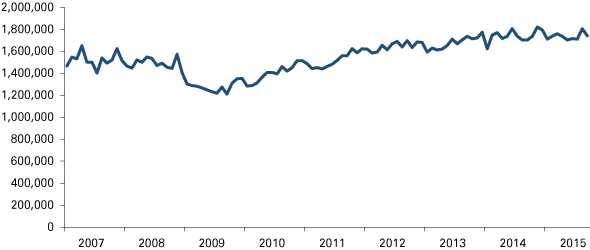
Source: U.S. Bureau of Labor Statistics and the Indiana Department of Workforce Development
While the number of jobs has grown and the unemployment rate has fallen, it appears the oppportunities for “overtime” or measures of “full employment” may have been pressured downward, possibly as a function of the rolling out of the health care law or for some other basket of reasons. Nonetheless, jobs are up, unemployment is down, and yet hours worked and income have been flat over the past year.
Leading Indicators
Leading Indiana Index (LII) and Consumer Sentiment: These index numbers relate to Indiana and the United States, respectively, yet they also impact Columbus inasmuch as they set a tone for the macroeconomic environment. Since 2009, both of these measures had been increasing through June 2015, indicating economic expansion.
Since the recovery began in earnest in January 2011, the LII11 has averaged 1.87, measured monthly, while Consumer Sentiment12 has averaged 79.4 over the same period. Currently, the LII stands at 0.97 and the Consumer Sentiment Index stands at 87.2. Both indicators have dropped in four of the most recently measured five months, which is hardly a long-term economic trend, but does suggest a bit of caution (see Figure 4).
Figure 4: Leading Indiana Index and Consumer Sentiment
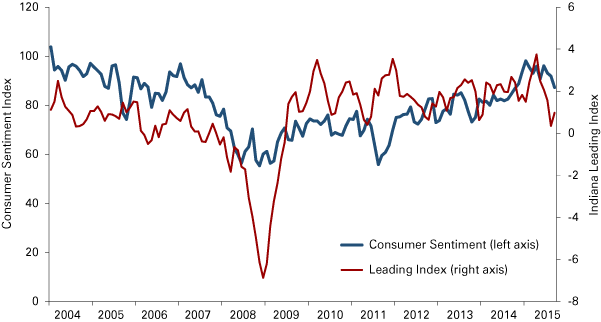
Source: Philadelphia Federal Reserve Bank and the University of Michigan
Yield Curve: The yield curve for U.S. treasuries remains in normal form. Short-term rates remain near zero, while 30-year securities continue to hover around 3.0 percent as of November 6, 2015.13 Inversion seems unlikely at this point, as inflationary threats remain unseen and the Federal Reserve board continues to capitulate the decision to increase short-term rates (see Figure 5).
Figure 5: U.S. Treasury Yield Curve 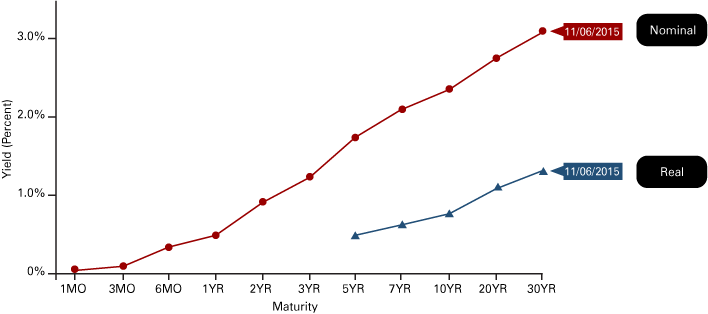
Source: U.S. Department of the Treasury
Local Building Permits: In 2009, 125 residential building permits were filed in Bartholomew County.14 Subsequently, each following year to date saw increases in the number of residential building permit filings. In 2014, 254 building permit applications were filed, while 200 permits have been filed in 2015 through September, and the latest 12 months (October 2014–September 2015) show 269 permit applications on file. All of these numbers are increases year-over-year, showing continued strength in the Columbus economy (see Figure 6).
Figure 6: Nominal GDP and Building Permits in Columbus MSA
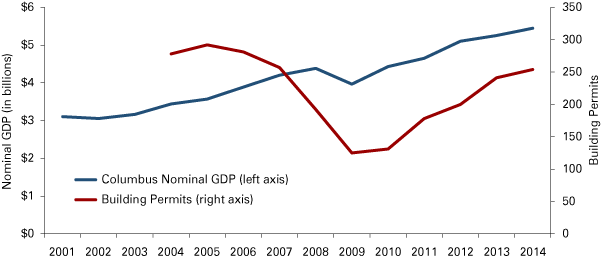
Source: U.S. Bureau of Economic Analysis (nominal GDP) and the U.S. Census Bureau (building permits)
Local Nominal GDP Growth: Also since 2009, nominal GDP has risen in the Columbus MSA year-over-year, from $3.97 billion to the 2014 output of $5.45 billion.15 With inflation at historic lows from 2009 to 2014, real GDP has also been tracking upward. In the easy-credit environment in the wake of the Great Recession, Columbus has experienced strong GDP growth leading into this 2016 forecast (refer back to Figure 6).
Columbus Area Stock Index (CASI): The composition of the Columbus economy may be reflected by an index of publicly traded securities relevant to the community. CASI was developed as a tool to keep abreast of the returns performance of securities affecting the local community and as a tool useful for forecasting local economic conditions.16 CASI is an economy-size-weighted index, which weights each component by the number of total jobs estimated to be produced and available in the Columbus MSA. Therefore, securities were selected using area employment as the basis for inclusion in the index. Not all sectors in the local economy were considered. Where the economic condition of a sector was estimated to change relative to some other independent sector, then the dependent sector was excluded.
Figure 7 shows a graphic of the major Columbus-area employment sectors, how they are interrelated, and to what extent each plays a role in the health and vitality of the local economy by providing jobs. Weights reflect the percentage of the core or base employment jobs available within the Columbus MSA. Support jobs are not included in this analysis. Thus, for instance, of the base jobs in the Columbus MSA, nearly two-thirds of them are in manufacturing.
Figure 7: CASI Sectors Included for the Columbus Core Economy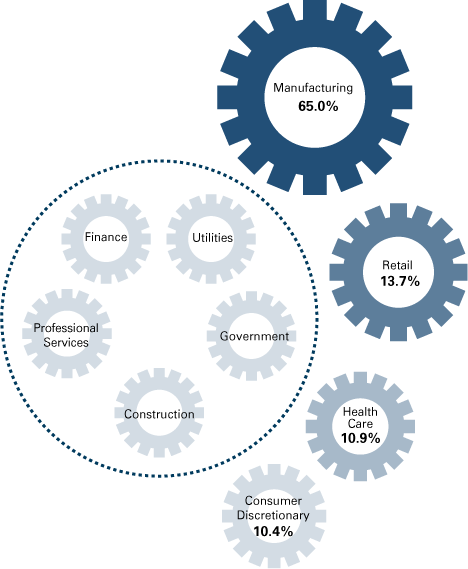
Source: Indiana University–Purdue University Columbus
It is estimated that manufacturing, retail (e.g., grocery and staples), consumer discretionary (e.g., restaurants, hotels, hospitality and tourism), and health care are the core, independent sectors in the Columbus economy. Remaining sectors—including finance, utilities, government, professional services, and construction—were estimated to rise and fall according to the performances of the four independent sectors. Once the core sectors were identified, securities were then selected to represent active participation in the local economy. These securities were then weighted according to the estimated numbers of jobs filled by each organization or group (see Table 2).17
Table 2: Components of Columbus Area Stock Index
| Independent Sector (Sector Weight) | Proxy | Percentage | Weighting | Scaled Weights |
|---|---|---|---|---|
| Health Care (10.89%) | Vanguard ETF | 10.89% | 4.76 | 10.89 |
| Consumer Discretionary (10.44%) | Vanguard ETF | 10.44% | 4.57 | 10.44 |
| Manufacturing (64.95%) | Cummins | 39.76% | 17.39 | 39.76 |
| Faurecia (private auto supply) | 8.02% | 3.51 | 8.02 | |
| Honda | 5.83% | 2.55 | 5.83 | |
| Ford (proxy for other auto suppliers) | 5.83% | 2.55 | 5.83 | |
| Toyota | 5.51% | 2.41 | 5.51 | |
| Retail (13.72%) | Simon Property Group | 3.43% | 1.50 | 3.43 |
| Wal-Mart | 5.72% | 2.50 | 5.72 | |
| Target | 2.29% | 1.00 | 2.29 | |
| Lowe’s | 2.29% | 1.00 | 2.29 |
Source: Indiana University–Purdue University Columbus
Where no individual security could be found, such as is the case for health care and consumer discretionary sectors, Vanguard ETFs were selected to approximate local employer return performance. The index was then created looking at weekly adjusted close prices over the 11-year period from 2004 through 2015, and compared to the S&P 500 (weekly adjusted close prices), which is a market capitalization value-weighted index.18 The S&P 500 weekly adjusted close hit its low point on February 2, 2009. ^GSPC is an ETF reflecting the S&P 500, and its value on that date was 735.09. On that same date, the CASI was measured at 109.73, whereas the 10-year low was measured at 82.54 on March 2, 2009.
Over the 12 months between October 27, 2014 and November 2, 2015, the S&P 500 gained 4.3 percent, while CASI dropped 18 percent (see Figure 8).
Figure 8: CASI and S&P 500 Performance Comparison
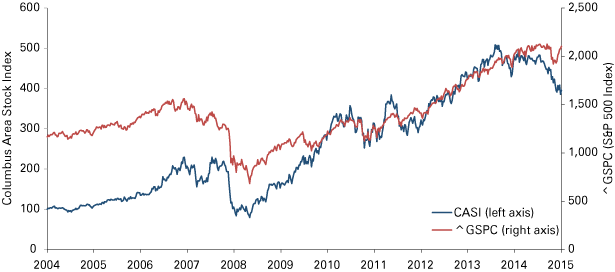
Source: Author’s calculations and Yahoo Finance
Since May 18, 2015, the S&P 500 has lost 1.0 percent, while CASI has lost 18.0 percent of its value. This is largely due to lagging performance in CMI (Cummins Inc.), which has lost about 25 percent of its value over that time. This suggests caution to the Columbus economy going forward.
National and Global Considerations
National Concerns: A primary concern going forward is the effect on the U.S. economy of the end of the zero percent short-term Federal Funds rate. On September 13, 2012, the Federal Reserve voted 11-1 in favor of the third round of quantitative easing (QE), after which equity securities experienced a two-year bull market without interruption until October 2014, at the end of QE. Over that stretch, the S&P 500 gained 17.4 percent annualized returns while CASI grew at 20.1 percent annually. QE provided markets with a form of credit liquidity not unlike the zero Federal Funds rate, which is expected to end in the coming year. During the aftermath of the Great Recession, the S&P experienced volatility while American corporations built up working capital levels and were slow to hire workers—all of which was moderated by QE and a zero Federal Funds rate. QE was terminated in October 2014, and since that time, the S&P has been volatile without any returns, while CASI experienced even greater volatility and lost value. Questions exist going forward as to how equity values will respond in the absence of zero interest rates, as well as how additional volatility in the equities markets will impact consumer confidence, spending and jobs. We have no experience as a country coming off QE or coming off a zero Federal Funds rate. We are entering uncharted waters.
Purchasing Manager’s Index (PMI): The October 2015 PMI report shows a reading of 50.1 percent, the lowest reading since May 2013. But it is still above the 50 percent mark, which suggests the manufacturing economy remains in expansion mode for the 34th consecutive month. The PMI has been greater than 43.1 percent for 77 consecutive months, which indicates expansion of the overall U.S. economy. This month’s reading suggests a national economic expansion of 2.8 percent, annualized.19
Global Concerns: China continues to experience growth weakness, alongside continued weakness in Russia, Brazil and western Europe. Uncertainty abroad seems to be the predominant news. Yet at the same time, the October 2015 jobs report for the U.S. was bullish (+271,000 jobs) and the overall U.S. unemployment rate is now 5 percent, the lowest in seven years. Meanwhile, commodities denominated in dollars have been declining in value across all markets. For instance, oil remains at unexpectedly low levels, trading at under $44 per barrel.20 Implications for cheap commodities and oil may not be well understood, yet certainly many sectors have been harmed, including energy and mining, worldwide. These two sectors in particular have proven material in decelerating sales growth for Cummins in their high horsepower engine and power generation segments, largely overseas. It remains unknown when energy and commodities prices will recover, but while these segments are low, Cummins will continue to run lean.
Outlook
The Columbus, Indiana, economic outlook for 2016 is neutral to slightly negative, with reasons for continued growth overshadowed by suspicions that the economic expansion seen in Columbus over the last seven years may be facing headwinds.
Upside potential
Leading Indicators: Local residential building permits are up to a latest-12-months figure of 269, a number not seen since 2006, which can be predictive of economic expansion over the coming year. PMI remains above 50, which implies continued manufacturing expansion.
Additional Planned Investment:21 Locally, some stakeholders are planning business expansions, infrastructure improvements, and some have stated modest future hiring in the area. For instance, Daiei Inc. plans a $3.3 million capital investment and expects to hire five employees for its headquarters and a small manufacturing site, with estimated completion in 2017.22 Toyota is also investing in Columbus, with a planned $16 million new national headquarters for its material handling division that will include enhanced amenities for its current Columbus-based workforce of about 1,275.23 Faurecia announced plans to invest $70 million in a new manufacturing plant along with plans to hire an additional 131 employees by the end of 2017.24 Columbus continues to leverage its convenience and architecture to grow its tourism program with several hundred annual events drawing in visitors from around the Midwest, generating an estimated $30 million in annual economic impact.25 The Golden Foundry site located in the center of Columbus is now set for development into a 200-unit apartment complex, with $25 million in investment, which promises to gentrify one of the few opportunities within the city.26
Neutral
Automotive Industry: With an annualized sales rate of 18.1 million units as of October, U.S. cars and light truck sales are poised to surpass the year 2000 record of 17.4 million.27, 28 Auto sales are expected to increase in 2016 by 2.3 percent over 2015 levels, but are forecasted to gradually decline beginning in 2017.29 Thus, while the projected growth in 2016 could be a temporary positive for Columbus, the expected industry decline may hinder capital investment or sustainable job growth. If the sales decline begins earlier than 2017, this may impact the Columbus economy sooner. In any event, it appears that the automotive sector may be entering the tail end of its business cycle.
Employment Base: Columbus boasts the lowest unemployment rate in the region, at 3.0 percent. This suggests that manufacturing employers prefer the skill and ethic of the Columbus workforce and the accessibility to workers and infrastructure. However, the sword cuts both ways, as workers are increasingly hard to come by. Thus, certain companies (such as NTN Driveshaft—which is headquartered in Columbus) have chosen to invest elsewhere. NTN Driveshaft announced plans for a $129 million capital investment and the creation of 450 jobs in Anderson, Indiana.30 As of September 2014, Anderson had a labor force of 41,300 and an unemployment rate of 5.8 percent.31 While still good for Indiana, this is an example of a local company deciding to locate where it might have a better opportunity to find workers.
Downside Potential
Leading Indicators: The Indiana Leading Index, which is driven significantly by manufacturing, has dropped in four of the most recent five months and has experienced significant volatility this year.32 Consumer sentiment has also dropped in four of the last five months, as we head into the holiday shopping season. The CASI, a stock index weighted to reflect the Columbus metro area, is at a 27-month low, trading at a level 18.2 percent off of its 2015 high (which was measured on January 20, 2015).
Cummins: Cummins just lowered its forecasts for the fourth quarter of 2015 and for all of 2016 on weaker than expected third quarter 2015 results, with sales losses in engines (-10 percent), power generation (-13 percent) and components (-4 percent). Distribution sales are up by 20 percent this year, due to the distribution acquisition in an earlier period. Continued weakness in mining and lower demand for durable goods caused by a higher interest rate environment may jeopardize North American heavy-duty engines and components sales going forward, which had been strong through mid-year 2015. Class 8 heavy-duty engines commonly seen in long-haul semi-trucks are expected to peak with sales above 330,000 units in 2015, with 10 percent drops expected in 2016 and 2017.33 Medium-duty truck engines and bus engines continue to show significant sales and earnings, with sound growth prospects into the coming year. Entry into light-duty trucks provides additional opportunity for new markets, yet with unproven financial economics.
Multinational Synergy: Weakness in economic growth persists throughout the world, which has altered growth opportunities for Cummins, particularly for high horsepower engines and associated components, as well as power generation in developing economies. Cummins currently is carrying forth plans to reduce its local professional workforce by about 500 employees by the end of 2015.34 Also, the strong dollar may begin to affect other local manufacturing firms having global supply chains either by reducing demand for international customers or cooling potential for acquiring new international markets.
Conclusion
With a 44,000 labor force in place, plus access to 1.7 million people within a 45-minute commute, Columbus could be positioned to experience another year of economic prosperity in 2016.35
However, due to complications arising from global weakness, automotive and class 8 engine sales peaking, upward pressures on interest rates, struggles for Cummins in key businesses worldwide, and increasing difficulty for new corporate prospects to find workers in the low unemployment environment, Columbus is most likely to experience net flat job growth or net contraction in 2016.
Columbus stands to continue to attract capital investment and people and retain its share of high-income jobs, while slow international economic growth and cooling North American markets may hamper opportunities for significant expansion.
Growth in the manufacturing sector can be expected to persist going forward, particularly as short-term interest rates remain near zero; however, changes to consumer borrowing costs in the coming year will likely yield a chilling effect on demand for the products built in the Columbus area.
Notes
- Taken from StatsAmerica’s USA Counties in Profile on 11/5/2015.
- U.S. Bureau of Economic Analysis data taken from http://www.stats.indiana.edu/bea/simple/pi.html on 11/6/2015. 2014 data were not yet released.
- “Local labor force” is used interchangeably and synonymously with “local and employed.”
- Milken Institute, “2014 Best-Performing Cities: Where America’s Jobs Are Created and Sustained,” January 2015, 33, https://milkeninstitute.org/report/best-performing-cities-2014.
- Ryan Brewer, “Columbus Forecast 2015,” Indiana Business Review, Winter 2014, www.ibrc.indiana.edu/ibr/2014/outlook/columbus.html.
- Julie McClure, “Moravec begins another historical landmark transformation,” The Republic, July 20, 2015, www.therepublic.com/view/local_story/Moravec-begins-another-histori_1437406802.
- Megan Banta, “Company gets abatement to add 30 jobs,” The Republic, December 3, 2014, www.therepublic.com/view/local_story/Company-gets-abatement-to-add-_1417655489.
- Columbus Indiana Economic Development Board, “Columbus Automotive Manufacturer Announces Multimillion Dollar Expansion, Creating 131 New Jobs,” May 20, 2015.
- Columbus Indiana Economic Development Board, “Toyota Industrial Equipment Celebrates 25 Years with $16 Million Investment,” August 23, 2015, http://www.columbusin.org/toyota-industrial-equipment-celebrates-25-years-with-16-million-investment/.
- Data taken from STATS Indiana on 11/3/2015: http://www.stats.indiana.edu/ces/ces_naics/.
- State leading index data taken from the Federal Reserve Bank of Philadelphia website on 11/3/2015: https://www.philadelphiafed.org/research-and-data/regional-economy/indexes/leading/.
- Consumer sentiment data taken from the University of Michigan website on 11/1/2015: http://www.sca.isr.umich.edu/.
- U.S. Department of the Treasury data taken from http://www.treasury.gov/resource-center/data-chart-center/interest-rates/Pages/Historic-Yield-Data-Visualization.aspx on 10/31/2015.
- U.S. Census Bureau data taken on 11/1/2015 from https://www.census.gov/construction/bps/.
- U.S. Bureau of Economic Analysis data taken on 11/1/2015 from http://www.bea.gov/iTable/iTable.cfm?reqid=70&step=1&isuri=1&acrdn=2#reqid=70&step=1&isuri=1&7003=900&7004=naics&7035=-1&7005=1&7006=14020,18020,21780,26900,29020&7001=2900&7036=-1&7002=2&7090=70&7007=-1&7093=levels.
- Ryan Brewer, “Columbus Forecast 2015,” Indiana Business Review, Winter 2014, www.ibrc.indiana.edu/ibr/2014/outlook/columbus.html.
- Employment information for local employers was retrieved from Hoosiers by the Numbers on 10/31/2015 from www.hoosierdata.in.gov/highlights/profile.asp?geo_val=S18;C005&page_id=6.
- Weekly adjusted close prices were retrieved from www.yahoo.com/finance on October 31, 2015. Adjustments include stock splits and dividends over the period.
- Institute for Supply Management, “October Manufacturing ISM Report on Business,” November 2, 2015, https://www.prnewswire.com/news-releases/pmi-at-501-october-manufacturing-ism-report-on-business-new-orders-and-production-growing-supplier-deliveries-slowing-employment-and-inventories-contracting-300169253.html.
- News releases taken from Yahoo.com at www.cnbc.com/2015/10/13/us-stocks-seen-lower-after-weak-china-trade-data.html on 11/9/2015.
- Previously planned investments (e.g., Kroger and the GM dealership) not yet online but announced in 2014 or earlier are not included in this discourse.
- Julie McClure, “Japanese Manufacturer Coming to City,” The Republic, November 3, 2015, www.therepublic.com/view/local_story/Japanese-manufacturer-coming-t_1446552098.
- Julie McClure, “$16 Million Project Serves Needs for Company, Employees,” The Republic, August 3, 2015, www.therepublic.com/view/local_story/-16-million-project-serves-nee_1440375621.
- Columbus Indiana Economic Development Board, “Columbus Automotive Manufacturer Announces Multimillion Dollar Expansion, Creating 131 New Jobs,” May 20, 2015.
- Ryan Brewer, “Columbus Forecast 2015,” Indiana Business Review, Winter 2014, www.ibrc.indiana.edu/ibr/2014/outlook/columbus.html.
- Julie McClure, “Former Foundry Site Gets Abatement,” The Republic, October 24, 2015, www.therepublic.com/2015/10/25/former_foundry_site_gets_abatement_for_complex/.
- Federal Reserve Bank of St. Louis, “Light Weight Vehicle Sales: Autos and Light Trucks,” accessed 11/9/2015, https://research.stlouisfed.org/fred2/series/ALTSALES.
- Claire Groden, “U.S. Auto Sales at 10-Year High,” Fortune Magazine, October 1, 2015, http://fortune.com/2015/10/01/u-s-auto-sales-at-10-year-high/.
- Jim Henry, “U.S. Auto Sales Top Out in 2016, Dealer Association Economist Predicts,” Forbes, June 30, 2015, www.forbes.com/sites/jimhenry/2015/06/30/u-s-auto-sales-top-out-in-2016-dealer-association-economist-predicts/.
- “NTN Driveshaft Has Plans to Expand in Anderson,” The Republic, July 7, 2015, www.therepublic.com/view/local_story/NTN-Driveshaft-has-plans-to-ex_1436275423.
- Taken from StatsAmerica’s USA Counties in Profile on 10/30/2015.
- Federal Reserve Bank of Philadelphia data taken on 11/3/2015: https://www.philadelphiafed.org/research-and-data/regional-economy/indexes/leading/.
- Seth Clevenger, “Class 8 Sales Will Hit Peak in 2015, ACT Forecast Says,” Transport Topics, March 30, 2015, www.ttnews.com/articles/printopt.aspx?storyid=37808.
- Kirk Johannesen, “Cummins Layoffs Set to Start in a Few Weeks, The Republic, November 2, 2015, www.therepublic.com/view/local_story/Cummins-layoffs-set-to-start-i_1446517679.
- Columbus Indiana Economic Development Board, “Labor Force,” www.columbusin.org/facts-figures/labor-force/.




